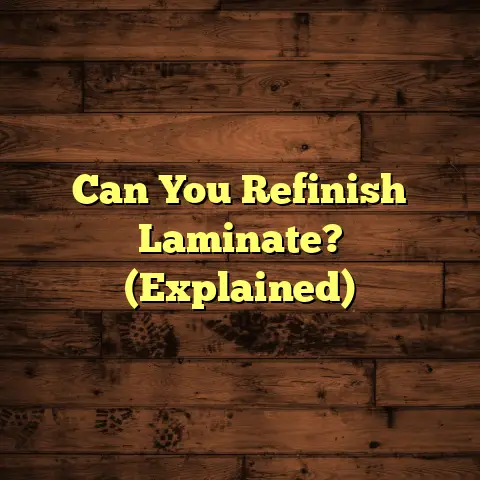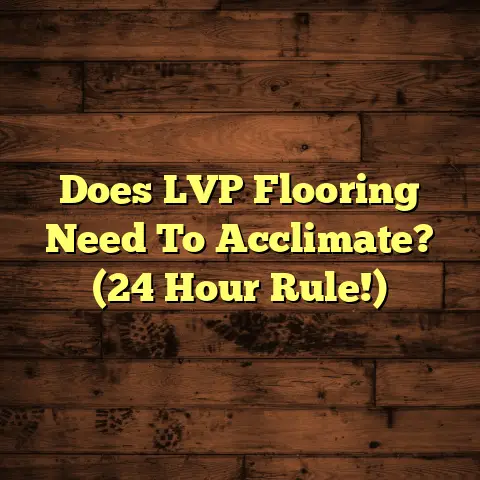Vinyl Over Gym Carpets? (3 Mistakes Costly!)
Did you know that over 60% of gyms report issues with their flooring?
It’s a shocking statistic, isn’t it?
Leading to costly repairs and maintenance.
Flooring is the unsung hero of any gym, and getting it wrong can lead to a world of hurt.
I’ve seen it happen countless times in my years as a flooring contractor.
Let’s dive in, shall we?
1. Understanding Gym Flooring
Gym flooring isn’t just about aesthetics; it’s about safety, durability, and maintenance.
Think about it: what other surface takes such a beating?
From dropped weights to sweaty feet, gym floors endure a lot.
There’s a whole world of gym flooring options out there, but let’s focus on the two main contenders: vinyl and carpet.
- Carpet:
- Traditionally, carpet has been used in gyms for its cushioning and sound-dampening properties.
- But, boy, does it trap sweat and bacteria!
- Vinyl:
- On the other hand, vinyl is known for its durability and ease of cleaning.
- It’s resistant to moisture and can withstand heavy traffic.
The right choice depends on the specific needs of your gym.
For example, a yoga studio might benefit from the softness of carpet, while a weightlifting area demands the resilience of vinyl.
The choice of flooring significantly impacts the safety, durability, and maintenance of your gym.
Think about the impact absorption needed for weight training versus the slip resistance required for a cardio area.
2. The Rise of Vinyl Flooring
Vinyl flooring has become increasingly popular in gyms.
There’s a good reason for that.
It’s tough, easy to clean, and comes in a variety of styles.
Gym owners often consider installing vinyl over existing gym carpets for several reasons:
- Cost-effectiveness:
- It can be cheaper than tearing out the old carpet and installing a completely new floor.
- Aesthetics:
- Vinyl can instantly update the look of a gym, making it more modern and appealing.
- Functionality:
- It provides a smooth, durable surface that’s easy to clean and maintain.
One of the biggest advantages of vinyl is its resistance to wear and tear.
It can handle heavy foot traffic, dropped weights, and spills without showing signs of damage.
Plus, it’s available in a wide range of colors and patterns, allowing you to create a customized look for your gym.
However, installing vinyl over carpet isn’t always a slam dunk.
It can be a great solution, but only if you do it right.
And that’s where the mistakes come in.
3. Mistake #1: Skipping Preparation of the Underlying Carpet
This is where I see gym owners go wrong most often.
They think they can just slap vinyl over the existing carpet and call it a day.
Big mistake!
Failing to properly prepare the gym carpet before installing vinyl can lead to a host of problems.
The biggest issue is moisture retention.
Carpet, especially gym carpet, tends to trap sweat, spills, and other liquids.
If you cover it with vinyl, that moisture has nowhere to go.
This can lead to mold and mildew growth, creating an unhealthy environment for your members.
Plus, the trapped moisture can damage both the carpet and the vinyl, shortening their lifespan.
Another problem is uneven surfaces.
Carpet isn’t perfectly flat.
It has texture and padding that can create bumps and dips under the vinyl.
This can make the vinyl feel uneven and uncomfortable to walk on.
It can also cause the vinyl to wear unevenly, leading to cracks and tears.
I remember one gym owner who decided to install vinyl over his old, worn-out carpet without any preparation.
Within a few months, he started noticing a musty smell.
He also saw bubbles forming under the vinyl.
When he pulled up the vinyl, he found a nasty surprise: mold and mildew growing on the carpet.
He ended up having to tear out the entire floor and start from scratch.
Costing him way more than if he did it right.
How to Avoid This Mistake:
- Remove the carpet:
- The best option is to remove the carpet entirely and install the vinyl on a clean, level subfloor.
- Thoroughly clean the carpet:
- If you absolutely must install vinyl over carpet, make sure to clean it thoroughly with a professional-grade carpet cleaner.
- Address any unevenness:
- Use a self-leveling compound to fill in any dips or smooth out any bumps.
- Consider a vapor barrier:
- To prevent moisture from rising through the carpet, install a vapor barrier before laying the vinyl.
4. Mistake #2: Ignoring the Importance of Adhesives
Choosing the right adhesive is crucial for a successful vinyl installation.
Don’t skimp on this step!
Using the wrong type of adhesive or not using enough of it can lead to a variety of problems.
If the adhesive isn’t strong enough, the vinyl can start to peel up at the edges.
This creates a tripping hazard and can damage the vinyl.
If the adhesive isn’t compatible with the carpet or vinyl, it can break down over time, causing the vinyl to loosen and shift.
I’ve seen gyms where the vinyl literally slides around on the floor because the adhesive failed.
Not good!
The type of adhesive you need depends on several factors, including the type of vinyl, the type of carpet, and the amount of traffic the floor will receive.
For gym environments, I always recommend using a high-quality, moisture-resistant adhesive that’s specifically designed for vinyl flooring.
Avoid using cheap, generic adhesives.
They might save you a few bucks upfront, but they’ll end up costing you more in the long run.
One of the most common mistakes I see is not using enough adhesive.
Gym owners often try to stretch the adhesive to save money, but this is a recipe for disaster.
Make sure to apply the adhesive according to the manufacturer’s instructions, and don’t be afraid to use a little extra.
Recommended Adhesives for Gym Environments:
| Adhesive Type | Description |
|---|---|
- Loctite PL Premium Construction
Adhesive:
- A high-strength, versatile adhesive known for its superior bonding capabilities and resistance to moisture.
- It’s suitable for a wide range of materials and provides a durable bond.
- Bostik’s Best:
- A single-component, trowel-applied, 100% solids, urethane adhesive.
- It’s known for its superior bond strength and moisture resistance.
- Mapei ECO 980:
- A premium, wet-grab, acrylic adhesive designed for vinyl flooring.
- It offers excellent adhesion and is low in VOCs, making it a more environmentally friendly option.
5. Mistake #3: Not Considering the Gym’s Purpose and Traffic Levels
This is the final piece of the puzzle.
You need to think about how your gym is used and how much traffic it gets.
Different areas of a gym have different flooring requirements.
A weightlifting zone, for example, needs flooring that can withstand heavy impact and protect the subfloor.
A cardio area needs flooring that’s slip-resistant and comfortable to walk on.
A multipurpose studio needs flooring that’s versatile enough to handle a variety of activities, from yoga to aerobics.
If you don’t match your flooring choices with your operational needs, you’re asking for trouble.
I’ve seen gyms that installed the same type of vinyl throughout the entire facility, regardless of the activity taking place in each area.
The result?
The vinyl in the weightlifting zone cracked and chipped within months, while the vinyl in the cardio area became slippery and dangerous.
It’s important to consider the specific needs of each area of your gym when choosing flooring.
Think about the types of activities that will be taking place, the amount of traffic the floor will receive, and the level of impact the floor will need to withstand.
Flooring Considerations for Different Gym Areas:
| Gym Area | Flooring Considerations





